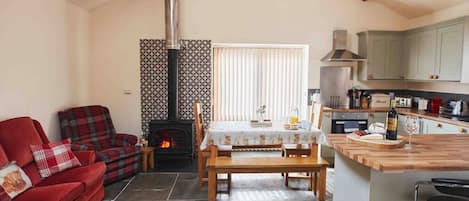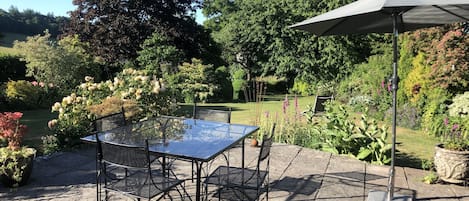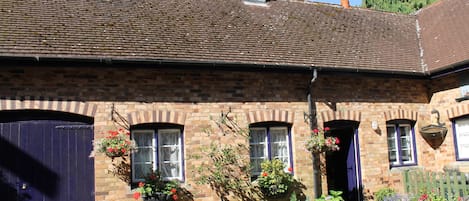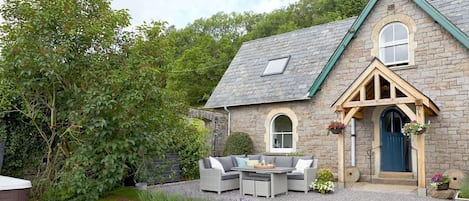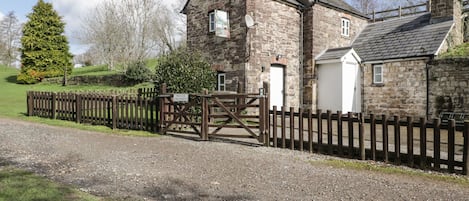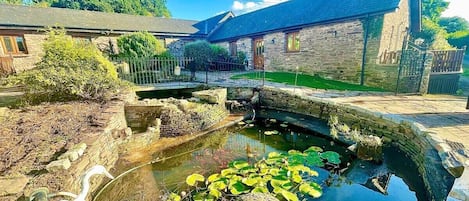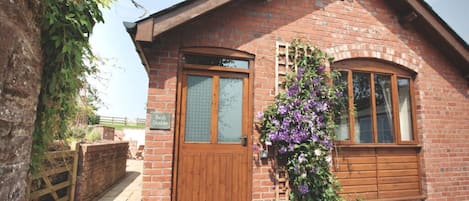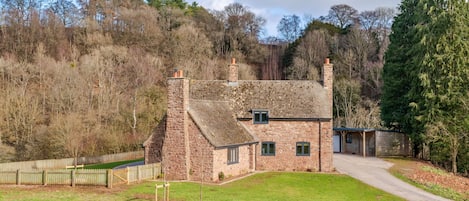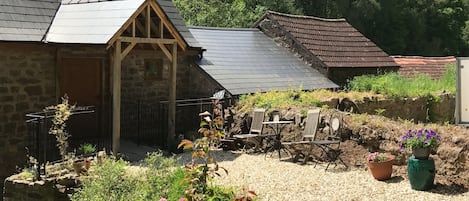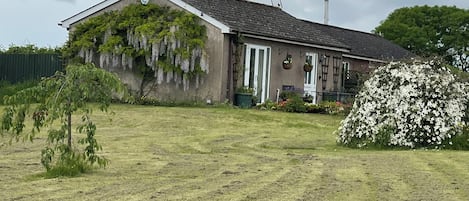Ganzes Ferienhaus
Detached ONE LEVEL stone barn
Fotogalerie von Detached ONE LEVEL stone barn

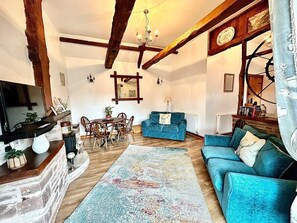
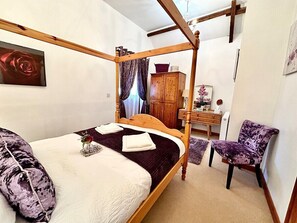
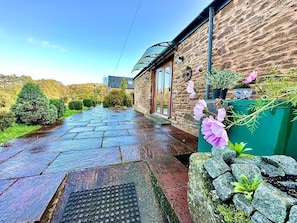

Bewertungen
10 von 10.
Außergewöhnlich
2 Schlafzimmer2 BadezimmerPlatz für 4 Gäste
Beliebte Annehmlichkeiten
Lerne die Gegend kennen
Monmouthshire, Wales
- Wye Valley13 Autominuten
- Chepstow Racecourse14 Autominuten
- Tintern Abbey20 Autominuten
- Bristol Filton Airport (FZO)51 Autominuten
Zimmer und Betten
2 Schlafzimmer (Platz für 4 Personen)
2 Badezimmer
Badezimmer 1
Badezimmer 2
Weitere Räumlichkeiten
Küche
Balkon
Garten
Mehr zu dieser Unterkunft
Detached ONE LEVEL stone barn
You’ll have plenty to enjoy at this historic place in a picturesque setting.
The barn was originally part of a 16th Century 200 acre farm.
Lovingly restored only using stone and wood from the original structure and outbuildings including ancient farming machinery found in the grounds.
The barn is steeped in history yet has all modern creature comforts including fully equipped kitchen, great sized living space and 2 Ensuite bedrooms.
One being a twin and the other a double.
Rowan is a rural and semi secluded cosy detached stone built barn that once upon a time was a cow shed for The Pentre Farm on the grounds of which the barn sits and it now hosts one twin room and one double, both en suite, spacious sitting/dining room and with excellent views, from the lounge of the pond below and valley beyond.
The private patio has seating area and the barn also has a private drive and large gardens to front and side.
Llangwm Uchaf is best known for the Church of St. Jerome. The oldest parts of the church date from the 12th century, built in the Early English style. The church was partly rebuilt by J. P. Seddon in the 1860s.
The church contains a remarkable medieval rood screen and rood loft, c. 1500, restored during Seddon's 19th-century reconstruction. It has been described as a breathtaking sight, rising almost to the roof and one of the most spectacular rood screens in South Wales.
It has been suggested that the village's remoteness saved the screen from destruction by the Puritans.
An ancient structure ornamented with trellis-work, possibly a stoup, a lamp or a piscina, was found built into the wall during restoration. Three "Green Men" with foliage issuing from their mouths are carved in the chancel arch.
Buried in the chancel of the church, though no memorial to him survives, is Walter Cradock, the 17th-century cleric born at Trefela 1.5 miles (2.4 km) south of the church. He was inspired to become an Independent by fellow church Dissenter William Wroth.
Swansea University historian Dr Alun Withey has examined in some detail a 1671 dispute over the church seating arrangements. He reports that the village was ablaze, with diverse variances, quarrels and debates even lawsuits, to the utter destruction and overthrow of manie. It was left to the churchwarden, respected local yeoman farmer John Gwin, to settle matters. Gwin's notebook containing his seating plan still survives, giving us, Withey argues, a rare insight into the world of parochial life in 17th-century Wales, and thus contributes greatly to our general understanding of Welsh history.
The church is a Grade I listed building It has been declared redundant and is in the care of the Friends of Friendless Churches. It was repaired in 2013–2014.
Church of St. John
The parish has a smaller second church, that of St. John at Llangwm Isaf. This church is located on the route to the Church of St. Jerome and is also in the Early English style, restored in the 19th century.
Baptist chapel
The Baptist chapel, situated at the south west end of the village, was built in 1840 on land given by Cradock Gwynne Watkins of the village. The building was financed by the local Baptists who, at that time, attended "Peniel", an older (now ruined) chapel on Golden Hill of which the chapel at Llangwm was a branch.
The exterior is cement rendered with a slate roof. There are three windows, with tracery on each side wall. A date-stone for 1840 is set above a tall pointed door entrance. The interior has a gallery at the entrance end and late-19th-century pews. The walls are finished in plain two-tone and the pulpit has a plain balustraded rail around. There is seating for approximately 100 persons.
The chapel, which is mentioned in Sir Joseph Bradney's A History of Monmouthshire (1923), was designated a Grade II listed building on 12 October 2000.
Gaer Fawr hill fort
The Iron Age hill fort at Gaer Fawr (meaning in Welsh, "great fort"), about 1 mile (1.6 km) south-east of Llangwm Uchaf, is one of the largest hill forts in Monmouthshire, and commands wide views over the Vale of Usk to the west, north and east.
We have some fantastic walks through and around the village and the whole area is very popular with cyclists and dog walkers.
The villagers are incredibly friendly and will always offer a little bit of help if needed on directions and lovely places to see.
We have SUPERFAST WIFI and smart TV.
The barn was originally part of a 16th Century 200 acre farm.
Lovingly restored only using stone and wood from the original structure and outbuildings including ancient farming machinery found in the grounds.
The barn is steeped in history yet has all modern creature comforts including fully equipped kitchen, great sized living space and 2 Ensuite bedrooms.
One being a twin and the other a double.
Rowan is a rural and semi secluded cosy detached stone built barn that once upon a time was a cow shed for The Pentre Farm on the grounds of which the barn sits and it now hosts one twin room and one double, both en suite, spacious sitting/dining room and with excellent views, from the lounge of the pond below and valley beyond.
The private patio has seating area and the barn also has a private drive and large gardens to front and side.
Llangwm Uchaf is best known for the Church of St. Jerome. The oldest parts of the church date from the 12th century, built in the Early English style. The church was partly rebuilt by J. P. Seddon in the 1860s.
The church contains a remarkable medieval rood screen and rood loft, c. 1500, restored during Seddon's 19th-century reconstruction. It has been described as a breathtaking sight, rising almost to the roof and one of the most spectacular rood screens in South Wales.
It has been suggested that the village's remoteness saved the screen from destruction by the Puritans.
An ancient structure ornamented with trellis-work, possibly a stoup, a lamp or a piscina, was found built into the wall during restoration. Three "Green Men" with foliage issuing from their mouths are carved in the chancel arch.
Buried in the chancel of the church, though no memorial to him survives, is Walter Cradock, the 17th-century cleric born at Trefela 1.5 miles (2.4 km) south of the church. He was inspired to become an Independent by fellow church Dissenter William Wroth.
Swansea University historian Dr Alun Withey has examined in some detail a 1671 dispute over the church seating arrangements. He reports that the village was ablaze, with diverse variances, quarrels and debates even lawsuits, to the utter destruction and overthrow of manie. It was left to the churchwarden, respected local yeoman farmer John Gwin, to settle matters. Gwin's notebook containing his seating plan still survives, giving us, Withey argues, a rare insight into the world of parochial life in 17th-century Wales, and thus contributes greatly to our general understanding of Welsh history.
The church is a Grade I listed building It has been declared redundant and is in the care of the Friends of Friendless Churches. It was repaired in 2013–2014.
Church of St. John
The parish has a smaller second church, that of St. John at Llangwm Isaf. This church is located on the route to the Church of St. Jerome and is also in the Early English style, restored in the 19th century.
Baptist chapel
The Baptist chapel, situated at the south west end of the village, was built in 1840 on land given by Cradock Gwynne Watkins of the village. The building was financed by the local Baptists who, at that time, attended "Peniel", an older (now ruined) chapel on Golden Hill of which the chapel at Llangwm was a branch.
The exterior is cement rendered with a slate roof. There are three windows, with tracery on each side wall. A date-stone for 1840 is set above a tall pointed door entrance. The interior has a gallery at the entrance end and late-19th-century pews. The walls are finished in plain two-tone and the pulpit has a plain balustraded rail around. There is seating for approximately 100 persons.
The chapel, which is mentioned in Sir Joseph Bradney's A History of Monmouthshire (1923), was designated a Grade II listed building on 12 October 2000.
Gaer Fawr hill fort
The Iron Age hill fort at Gaer Fawr (meaning in Welsh, "great fort"), about 1 mile (1.6 km) south-east of Llangwm Uchaf, is one of the largest hill forts in Monmouthshire, and commands wide views over the Vale of Usk to the west, north and east.
We have some fantastic walks through and around the village and the whole area is very popular with cyclists and dog walkers.
The villagers are incredibly friendly and will always offer a little bit of help if needed on directions and lovely places to see.
We have SUPERFAST WIFI and smart TV.
Unterkunftsmanager
Cymru Holidays
Premium-Gastgeber
Schütze deine Zahlung – buche immer über FeWo-direkt
Wenn dich jemand bittet, außerhalb unserer Plattform zu buchen oder zu zahlen, bevor du auf FeWo-direkt buchst, teile uns dies bitte mit.
Gib zur Preisangabe die Daten an
Ausstattung
Küche
Waschmaschine
Außenbereich
Parkplätze verfügbar
Ähnliche Unterkünfte

RURAL stone barn with Log Burner, tranquil setting
RURAL stone barn with Log Burner, tranquil setting
- Küche
- Waschmaschine
- Haustiere erlaubt
- Außenbereich
9.0 von 10, (4 Bewertungen)
Hausordnung
Check-in ab 15:00 Uhr
Mindestalter für die Miete: 18 Jahre
Check-out vor 11:00 Uhr
Kinder
Kinder (0–17 Jahre) erlaubt
Veranstaltungen
Veranstaltungen sind nicht gestattet
Haustiere
Keine Haustiere erlaubt
Rauchen
Rauchen ist nicht gestattet
Wichtige Informationen
Wissenswertes
Diese Unterkunft wird von einem professionellen Gastgeber verwaltet. Die Vermietung erfolgt zu gewerblichen, geschäftlichen oder beruflichen Zwecken.
Für zusätzliche Personen fallen möglicherweise Gebühren an, die abhängig von den Bestimmungen der Unterkunft variieren können.
Beim Check-in werden ggf. ein Lichtbildausweis und eine Kreditkarte, Debitkarte oder Kaution in bar für unvorhergesehene Aufwendungen verlangt.
Je nach Verfügbarkeit beim Check-in wird versucht, Sonderwünschen entgegenzukommen, sie können jedoch nicht garantiert werden. Eventuell fallen zusätzliche Gebühren an.
Partys oder Gruppenveranstaltungen sind auf dem Gelände der Unterkunft streng verboten.
Zur Gegend
Usk
Mitten in Usk befindet sich Detached ONE LEVEL stone barn. Usk Castle und Raglan Castle zählen zu den Sehenswürdigkeiten der Region. Wer etwas unternehmen möchte, wird hier fündig: Parva Farm Vineyard und St. Pierre Country Club. Du möchtest deinen Aufenthalt in der Stadt mit dem Besuch eines spannenden Events oder einer Sportveranstaltung aufpeppen? Dann schau doch einmal hier vorbei: Wales National Velodrome oder Newport Stadium.
Monmouthshire, Wales
In der Umgebung
- Usk Castle - 5 Autominuten - 5.4 km
- Celtic Manor Resort Golf Club - 12 Autominuten - 17.6 km
- Wye Valley - 13 Autominuten - 9.0 km
- Chepstow Racecourse - 14 Autominuten - 16.1 km
- Tintern Abbey - 20 Autominuten - 15.8 km
Fortbewegung vor Ort
Restaurants
- Groes Wen Inn - 20 Autominuten
- The Hall Inn - 7 Autominuten
- The Greyhound Inn - 10 Autominuten
- Sprokwobbles - 5 Autominuten
- Fountain Inn - 16 Autominuten
Häufig gestellte Fragen
Bewertungen
Bewertungen
Es gibt noch keine Bewertungen
Du kannst nach deinem Aufenthalt die erste Bewertung zu dieser Unterkunft abgeben.
Über den Gastgeber
Zu Gast bei Cymru Holidays
Premium-Gastgeber
Sie bieten ihren Gästen durchgehend großartige Erfahrungen.
Wie können wir unsere Website verbessern?Feedback eingeben


